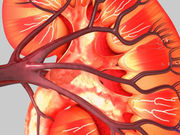Normalization seen in obese canines, by reducing hepatic gluconeogenic genes, including G6Pase
THURSDAY, Nov. 3, 2016 (HealthDay News) — In obese canines, bilateral renal denervation (RDN) normalizes hepatic insulin sensitivity (SI) by reducing hepatic gluconeogenic genes, according to a study published recently in Diabetes.
Malini S. Iyer, Ph.D., from the Cedars-Sinai Diabetes and Obesity Research Institute in Los Angeles, and colleagues measured SI using euglycemic hyperinsulinemic clamp before and after six weeks of high-fat diet (HFD), and after either RDN or sham surgery.
The researchers found that insulin resistance was induced in the liver after HFD. This insulin resistance persisted in sham animals, while RDN completely normalized hepatic SI in fat-fed dogs; normalization was via reduction of hepatic gluconeogenic genes, including G6Pase, PEPCK, and FOXO1. Upregulation of the liver-X-receptor via the natriuretic peptide pathway was the main mechanism for down-regulation of hepatic gluconeogenesis.
“In conclusion, bilateral RDN completely normalizes hepatic SI in obese canines,” the authors write. “These preclinical data implicate a novel mechanistic role for the renal nerves in the regulation of insulin action specifically at the level of the liver and show that the renal nerves constitute a putative new therapeutic target to counteract insulin resistance.”
Full Text (subscription or payment may be required)
Copyright © 2016 HealthDay. All rights reserved.








